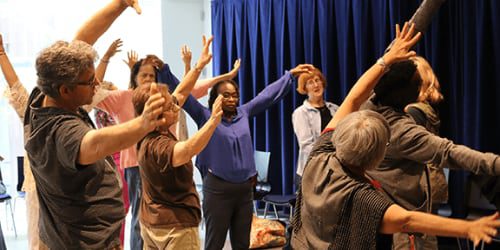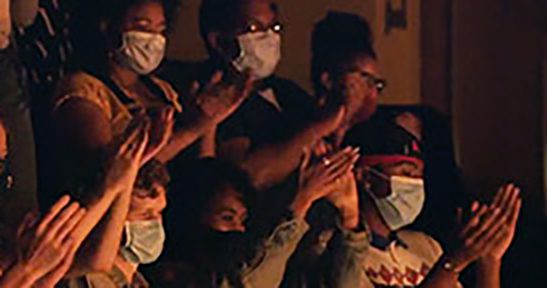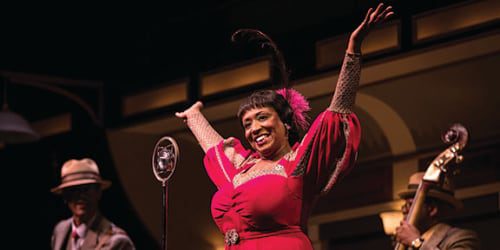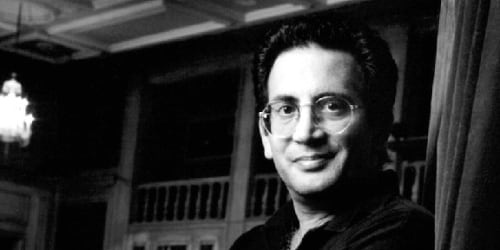The Who’s Tommy is on stage now!
GET TICKETS
In their second year at Acton Grammar School, Pete Townshend and John Entwistle formed a jazz group. It was the late 1950s and rock was in its infancy; artists like Elvis Presley, Fats Domino and Jerry Lee Lewis were captivating young fans in Britain and America as both countries enjoyed a period of post-war affluence and peace. The two boys’ foray into jazz proved brief–they only played one gig as a jazz band because both were more interested in rock. Roger Daltrey, a recent transplant to the neighborhood, spotted Entwistle carrying a bass on the street and asked him to play for a group he was forming called the Detours. Entwistle suggested that Townshend should join as a guitarist, and by 1961 the three were playing gigs together, along with Colin Dawson on vocals and Harry Wilson on drums. In 1964, the group became aware of another band called Johnny Devlin and the Detours, and determined that they should change their name. Ideas included The Hair, No One, and The Group, but Daltrey, still the de facto leader, chose The Who.
Over the next few years, the men developed their sound, lost and gained members, and briefly changed their name again (a manager renamed them The High Numbers) before reverting back to The Who. During one performance in 1964, Townshend accidentally damaged his guitar on a low ceiling. When the audience laughed, he grew frustrated and destroyed the instrument on stage. The following week, the audience wanted more. And thus, The Who began its practice of demolishing instruments onstage: an expensive habit, but one that perhaps paid for itself by selling additional tickets. In late 1964 the group recorded their single “I Can’t Explain,” which gained exposure with some limited radio play and The Who’s appearance on Ready Steady Go, a British television program that featured rock and pop music. By early 1965, the song charted in the top 10. By the end of that year, Townshend had penned “My Generation,” which would skyrocket to #2 on the British charts and cement The Who’s reputation as a major rock band of the 1960s.
Now bona fide rock stars, the members of The Who dealt with acrimony among the band (eventually, Daltrey was allowed to stay only on the condition that he allow others more decision-making powers), fame, drug abuse, and the highs and lows of touring life.
Tommy came about largely from Townshend’s desire to challenge what a rock album might be. Although a listener can enjoy the songs individually, the album is perhaps best listened to in one sitting because it forms a coherent story. Although it was not the first concept album, Tommy’s storyline differentiated it from most albums at the time and made it especially suitable for theatricalization.
Enter director Des McAnuff. A fan of the album since his teenage years, McAnuff was the artistic director of San Diego’s La Jolla Playhouse in the early 1990s when he began a collaboration with Townshend. The two used the existing music—by then more than two decades old—as the basis for storytelling, while also co-writing a libretto. The Who’s Tommy opened at the La Jolla Playhouse on July 1, 1992, and subsequently ran for 899 performances on Broadway. Pre-dating Rent by several years, The Who’s Tommy put rock music front and center, giving Broadway a much-needed update and attracting new fans to the genre of musical theater. It also introduced a new generation—one who listened to Nirvana, Rage Against the Machine, and Radiohead—to The Who’s music.
Now, 30 years later, Des McAnuff revives the 1990s hit. Pete Townshend—who wrote the album more than 50 years ago when he was 23 years old—will hear his music delight and inspire many audience members who don’t remember the 1960s (as well as some who do). And although Townshend claimed in one of The Who’s biggest hits to be “talkin’ ‘bout my generation,” it now seems that perhaps he was talkin’ ‘bout us all.
Neena Arndt is the Resident Dramaturg for Goodman Theatre.
Images provided by Trinifold Archive.
























